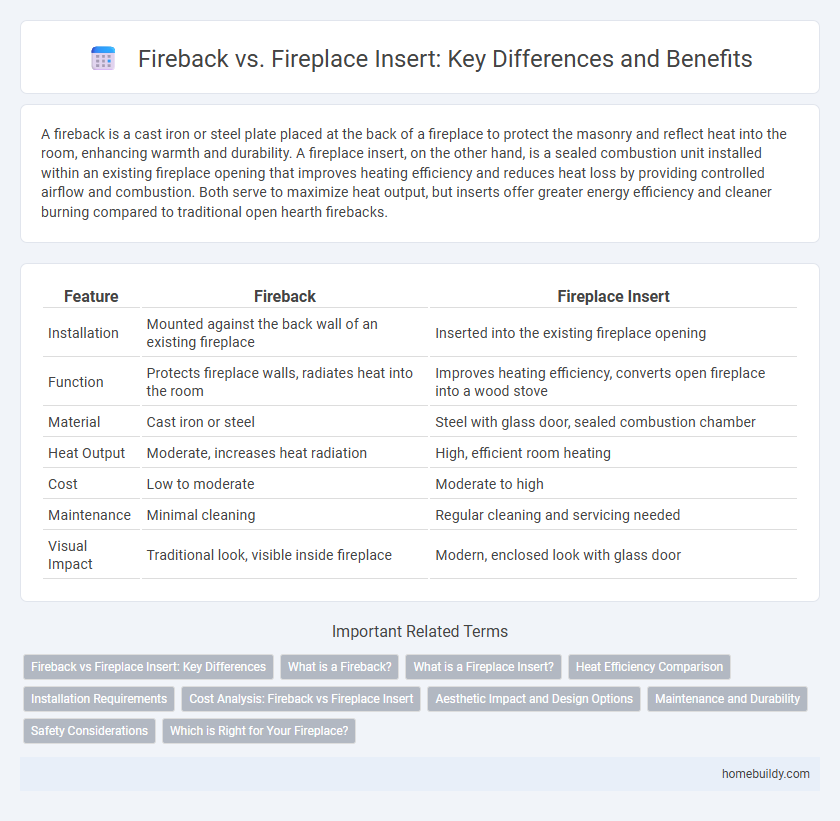A fireback is a cast iron or steel plate placed at the back of a fireplace to protect the masonry and reflect heat into the room, enhancing warmth and durability. A fireplace insert, on the other hand, is a sealed combustion unit installed within an existing fireplace opening that improves heating efficiency and reduces heat loss by providing controlled airflow and combustion. Both serve to maximize heat output, but inserts offer greater energy efficiency and cleaner burning compared to traditional open hearth firebacks.
Table of Comparison
| Feature | Fireback | Fireplace Insert |
|---|---|---|
| Installation | Mounted against the back wall of an existing fireplace | Inserted into the existing fireplace opening |
| Function | Protects fireplace walls, radiates heat into the room | Improves heating efficiency, converts open fireplace into a wood stove |
| Material | Cast iron or steel | Steel with glass door, sealed combustion chamber |
| Heat Output | Moderate, increases heat radiation | High, efficient room heating |
| Cost | Low to moderate | Moderate to high |
| Maintenance | Minimal cleaning | Regular cleaning and servicing needed |
| Visual Impact | Traditional look, visible inside fireplace | Modern, enclosed look with glass door |
Fireback vs Fireplace Insert: Key Differences
Firebacks and fireplace inserts serve distinct functions in enhancing fireplace efficiency and protection. A fireback is a cast iron plate installed at the back of a traditional open hearth to reflect heat into the room and protect the masonry, whereas a fireplace insert is a fully enclosed unit that fits into the fireplace opening, designed to improve heating efficiency by containing the fire and controlling airflow. Fireplaces inserts provide greater heat output and energy savings compared to firebacks, which primarily focus on heat reflection and structural preservation.
What is a Fireback?
A fireback is a heavy cast iron or steel plate positioned at the back of a fireplace to protect the masonry and reflect heat into the room. Unlike a fireplace insert that fits inside the fireplace opening to improve heating efficiency, a fireback primarily serves to enhance heat radiation and prolong the fireplace's structural life. Firebacks often feature decorative designs, combining functionality with aesthetic appeal.
What is a Fireplace Insert?
A fireplace insert is a sealed, energy-efficient wood, pellet, or gas-burning stove designed to fit directly into an existing masonry or factory-built fireplace, enhancing heat output and reducing energy loss. Unlike a fireback, which is a cast iron plate positioned at the back of a fireplace to reflect heat and protect the masonry, fireplace inserts come with their own combustion chamber and blower system. Inserts effectively transform traditional fireplaces into powerful heating appliances, improving overall home warmth and fuel efficiency.
Heat Efficiency Comparison
Firebacks and fireplace inserts both enhance heat efficiency but operate differently; firebacks increase heat radiation by absorbing and reflecting heat from the fire, typically boosting warmth by 10-15%. Fireplace inserts, designed as sealed units with built-in blowers, improve heat output by up to 70% compared to open fireplaces, making them more efficient at heating larger spaces. Choosing between a fireback and a fireplace insert depends on the desired heat output and installation complexity, with inserts providing superior efficiency for sustained heating.
Installation Requirements
Firebacks require minimal installation, typically placed directly against the rear wall of an existing fireplace to protect masonry and reflect heat. Fireplace inserts demand more extensive installation, involving fitting a sealed metal box into the existing fireplace cavity, often requiring modifications to the chimney or venting system for optimal airflow and safety. Choosing between them depends on whether a simple upgrade or a comprehensive heating solution with higher efficiency is desired.
Cost Analysis: Fireback vs Fireplace Insert
Firebacks typically cost between $200 and $600, offering an affordable way to improve fireplace heat efficiency by reflecting radiant heat into the room. Fireplace inserts, on the other hand, range from $1,500 to $3,500 or more, including installation, significantly increasing upfront expenses but providing superior heat output and fuel efficiency. Considering long-term energy savings, fireplace inserts often justify higher initial costs through reduced heating bills and enhanced safety features.
Aesthetic Impact and Design Options
Firebacks enhance the aesthetic impact of traditional fireplaces by showcasing ornate cast iron designs that reflect historical craftsmanship and add character to the hearth. Fireplace inserts offer a modern, streamlined look with various design options including glass fronts and sleek metal finishes, providing a contemporary upgrade to existing fireplaces. Choosing between a fireback and a fireplace insert depends on whether the priority is preserving vintage charm or achieving a more efficient, customizable heat source with updated stylistic appeal.
Maintenance and Durability
Firebacks are typically made of cast iron or steel, offering exceptional durability and resistance to high temperatures, which translates to minimal maintenance over time. Fireplace inserts, while also durable, incorporate moving parts such as fans and glass doors that require regular cleaning and occasional servicing to maintain efficiency. Firebacks provide a simpler, low-maintenance solution that enhances fireplace longevity without the complexity of mechanical components.
Safety Considerations
Firebacks provide a protective barrier that shields the fireplace's rear wall from excessive heat, reducing the risk of damage and improving safety. Fireplace inserts are designed with sealed glass doors and controlled airflow, minimizing the chance of sparks escaping and enhancing overall fire containment. Both options enhance safety but inserts offer superior protection by fully enclosing the fire.
Which is Right for Your Fireplace?
A fireback is a cast iron plate installed at the back of a fireplace to protect the masonry and reflect heat into the room, enhancing warmth without significantly altering the fireplace structure. In contrast, a fireplace insert is a sealed, efficient unit fitted inside an existing fireplace, designed to improve heating performance and reduce emissions. Choosing between a fireback and a fireplace insert depends on heating needs, budget, and whether preserving the traditional open fireplace aesthetic or upgrading to a more efficient heating solution is a priority.
Fireback vs Fireplace Insert Infographic

 homebuildy.com
homebuildy.com